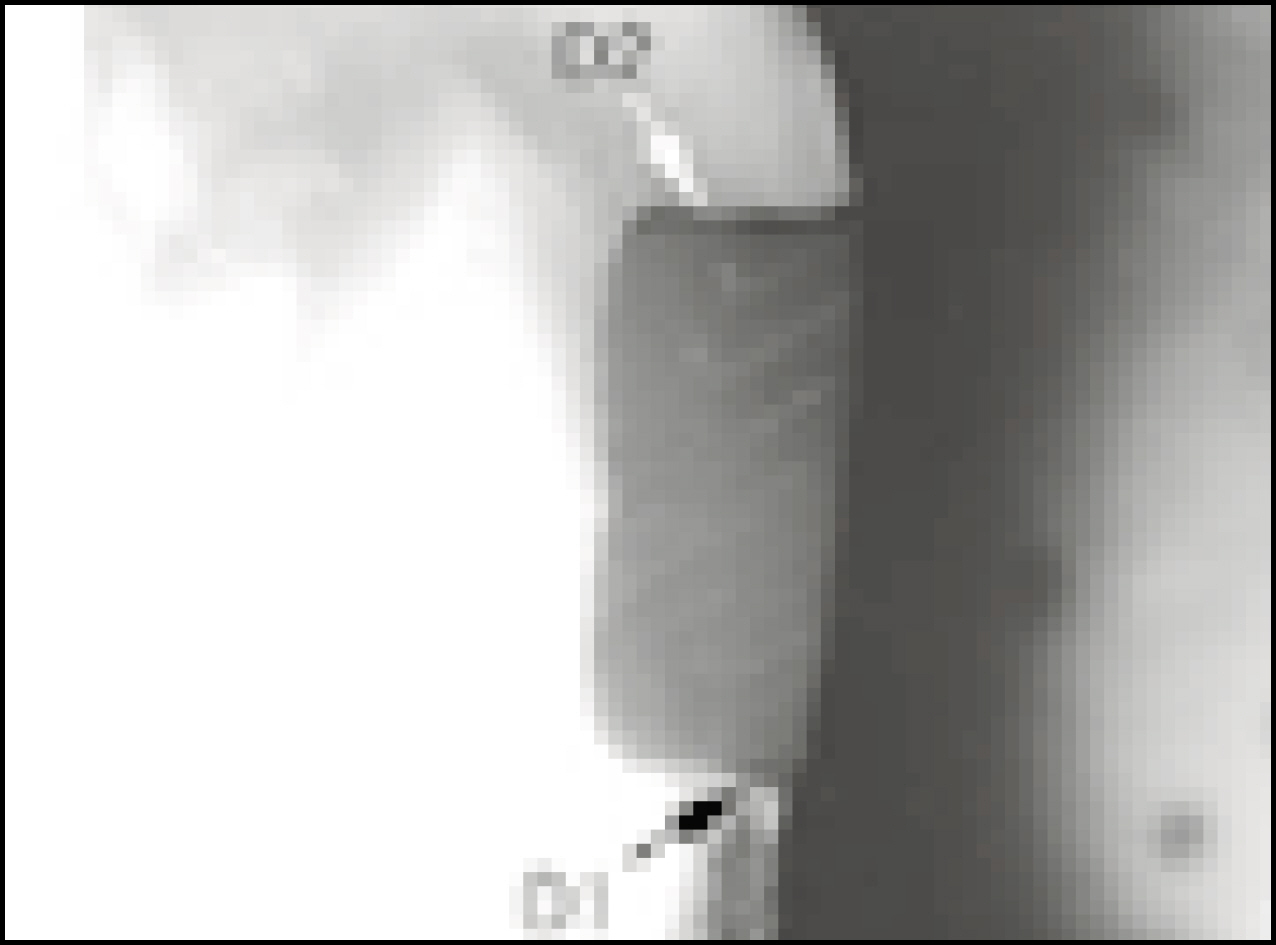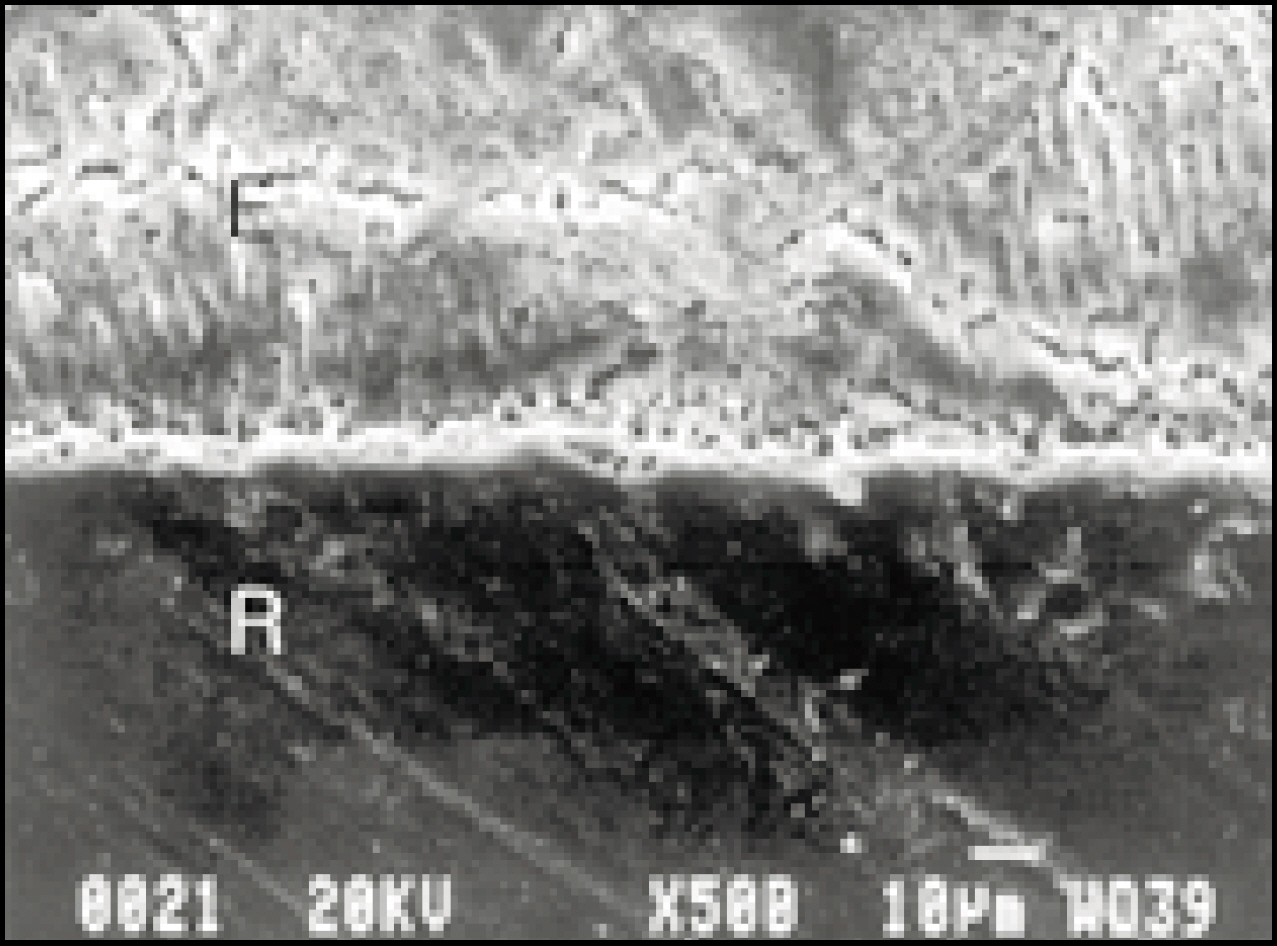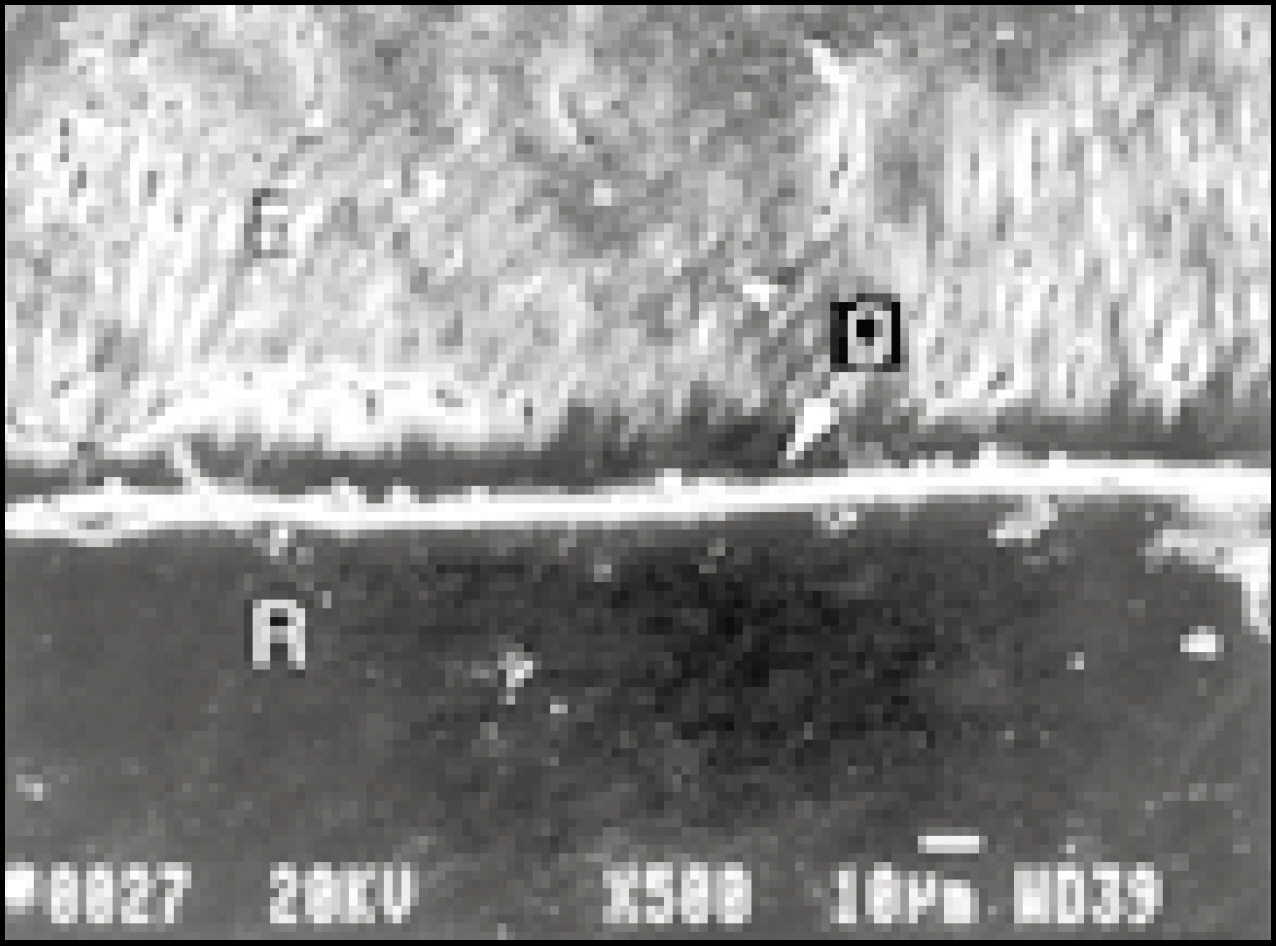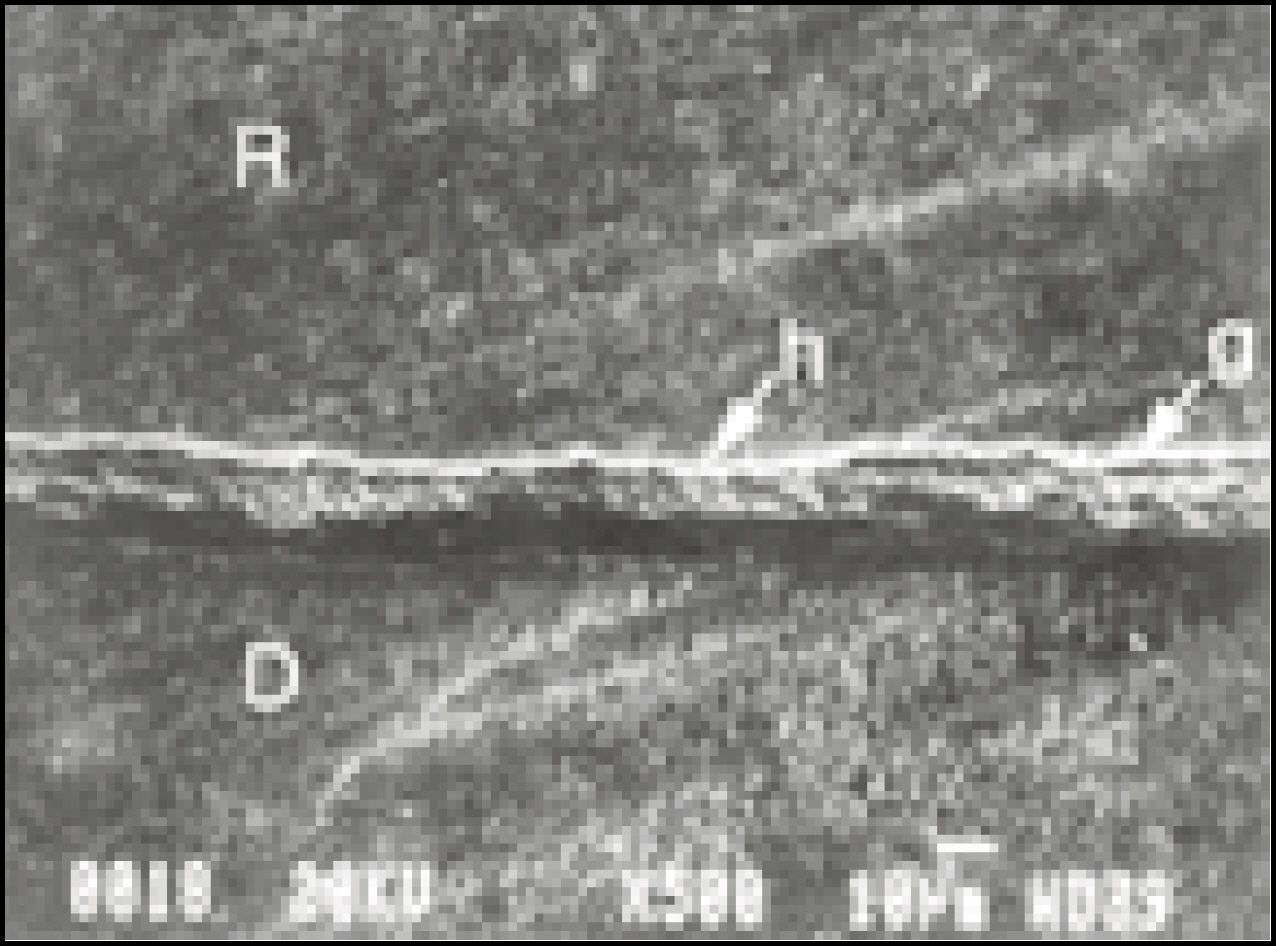J Korean Acad Conserv Dent.
2002 Jan;27(1):34-43. 10.5395/JKACD.2002.27.1.034.
Microleakage and marginal hybrid layer of dentin adhesives
- Affiliations
-
- 1Department of Conservative Dentistry, College of Dentistry, Chosun University, Korea.
- 2Department of Oral Medicine, College of Dentistry, Chosun University, Korea.
- KMID: 2175546
- DOI: http://doi.org/10.5395/JKACD.2002.27.1.034
Abstract
- The purpose of this study was to compare microleakage and marginal hybrid layer in class V restorations using two one-bottle adhesives and one self-etching adhesive. Class V cavity preparations with occlusal margins in enamel and gingival margins in dentin were prepared on buccal and lingual surfaces of 30 extracted human molar teeth. Prepared teeth were randomly divided into three treatment groups (n=30) and restored with three adhesives and composites: Single Bond/Filtek Z-250 (Group 1), Prime&BondNT/Esthet.X (Group 2), UniFil Bond/UniFil F (Group 3). For microleakage, samples were stored in room temperature water for 24 hours, thermocycled, stained with 2% methylene blue dye, sectioned into halves, scored and analysed using Mann-whitney test and Wilcoxon signed rank sum test. For marginal hybrid layer, samples were sectioned into halves, treated with 10% phosphoric acid for 5 seconds, stored in 5% NaOCL solution for 24 hours, dried and gold coated. Occlusal and gingival margins of each sample were inspected under SEM. The results of this study were as follows; 1. Microleakage at the occlusal margins was not evident in group 1 and group 2, but it showed in group 3 (p<0.05). 2. Microleakage in group 1 and group 3 was significantly lower than in group 2 at gingival margins (p<0.05). 3. Microleakage at gingival margins was greater than at occlusal margins in group 1 and group 2, but microleakage at occlusal margins was greater than at gingival margins in group 3 (p<0.05). 4. In group 1 and group 2, no gaps at occlusal margins showed. But gaps showed in group 3. Occlusal margins were free from a hybrid layer in all groups. 5. The thickness of the marginal hybrid layers was 2.5~5 microm thick in group 5 microm thick in group 2 and 1.5 microm thick in group 3. 6. There was no corelation between microleakage and thickness of marginal hybrid layer. In coclusion, the effect of dentin adhesives on microleakge in class V composite restorations was excellent when one-bottle adhesives were applied on enamel margin, and it was good when a self-etching adhesive was applied on dentinal margin. There was no corelation between microleakage and thickness of marginal hybrid layer.
MeSH Terms
Figure
Cited by 1 articles
-
The influence of IRM temporary restorations on marginal microleakage of dentin adhesives
Young-Gon Cho, Hyun-Kyung Kim, Young-Gon Lee
J Korean Acad Conserv Dent. 2003;28(1):1-10. doi: 10.5395/JKACD.2003.28.1.001.
Reference
-
References
1. Buonocore M.C.Simple method of increasing the adhesion of acrylic filling materials to enamel surface. J. Dent. Res. 34(6):849–853. 1955.2. Swift E.J., Perigao J., Heymann H.O.Bonding to enamel and dentin : A brief history and state of the art. Quint. Int. 26(2):95–110. 1995.3. Zheng L., Pereira P.N.R., Nakajima M., Sano H., Tagami J. Relationship between adhesive thickness and microtensile bond strength. Oper. Dent. 26:97–104. 2001.4. Nakayabashi N.Resin reinforced dentin due to infiltration of monomers into the dentin at the adhesive interface. The J. of the Japanese Society for Dental Materials and Devices. 1:78–81. 1982.5. Reeves G.W., Fitchie J.G., Hembree J.H. Jr., Puckett A.D.Microleakage of new dentin bonding systems using human and bovine teeth. Oper. Dent. 20(6):230–235. 1995.6. Al-Ehaideb A.A., Mohammed H.Microleakage of “one-bottle”dentin adhesives. Oper. Dent. 26:172–175. 2001.7. Gordan V.V., Vargas M.A., Cobb D.S., Denehy G.E.Evaluation of adhesive systems using acidic primers. Am. J. Dent. 10(5):219–223. 1997.8. Nakajima M., Sano H., Urabe I., Tagami J., Pashley D.H.Bond strength of single-bottle dentin adhesives to caries-affected dentin. Oper. Dent. 25:2–10. 2000.9. Ogata M., Okuda M., Nakajima M., Pereira P.N.R., Sano H., Tagami J.Influence of the direction of tubules on bond strength to dentin. Oper. Dent. 26:27–35. 2001.10. Prati C., Pashley D.H., Chersoni S., Mongiorgi R.Marginal hybrid layer in class V restorations. Oper. Dent. 25:228–233. 2000.11. Yoshiyama M., Urayama A., Kimochi T., Matsuo T., Pashley D.H.Comparison of conventional vs self-etching adhesives bonds to caries-affected dentin. Oper. Dent. 25:163–169. 2000.12. Gallo J.R., Burgess J.O., Xu X.Effect of delayed application on shear bond strength of four fifth-generation bonding systems. Oper. Dent. 26:27–35. 2001.13. Nakayabashi N.Dentinal bonding mechanism. Quint. Int. 22(2):73–74. 1991.14. Kanca J.Effect of resin primer solvents and surface wetness on resin composite bond strength to dentin. Am. J. Dent. 5(4):213–215. 1992.15. Gallo J.R., Comeaux R., Haines B., Xu X., Burgess J.O.Shear bond strength of four filled dentin bonding systems. Oper. Dent. 26:44–47. 2001.16. Pitter A.V., Heymann H.O, Swift E. Jr., Perdigao J., Rosa B.T.Effect of different re-wetting techniques on dentin shear bond strengths. J. Esth. Dent. 12:85–96. 2000.17. Hannig M., Reinhardt K.J., Bott B.Composite-to dentin bond strength, micromorphology of the bonded dentin interface and marginal adaptation of class Ⅱ composite resin restorations using self-etching primers. Oper. Dent. 26:157–165. 2001.18. Chigara H., Yukitani W., Hasegawa T., Manabe A., Itoh K., Hayakawa T., Debari K., Wakumoto S., Hisamitsu H.Self-etching dentin primers containing phenyl-P. J. Dent. Res. 73(5):1088–1095. 1994.19. Rosa B.T., Perdigao J.Bond strengths of nonrinsing adhesives. Quint. Int. 31:353–358. 2000.20. Watanabe I., Nakayabashi N., Pashley D.H.Bonding to ground dentin by a Phenyl-P self-etching primer. J. Dent. Res. 73(6):1212–1220. 1994.21. Nakayabashi N., sami Y.Bonding to intact dentin. J. Dent. Res. 75(9):1706–1715. 1996.22. Bakmeier W.W., Los A.A., Triolo P.T.Bond strength and SEM evaluation of Clearfil Liner Bond 2. Am. J. Dent. 8:289–293. 1995.23. Kanemura N., Sano H., Tagami J.“Tensile bond strength to and SEM evaluation of ground and intact enamel surfaces.”. J. Dent. 27:523–530. 1999.
Article24. Ogata M., Harada N., Yamaguchi S., Nakajima M., Pereira P.N.R., Tagami J.Effect of different burs on dentin bond strengths of self-etching primer bonding systems. Oper. Dent. 26:375–382. 2001.25. Latta M.A., Barkmeier W.W., Triolo P.T., Cavel W.T., Blankenau R.J.One year clinical evaluation of the Clearfil Liner Bond 2 system. J. Dent. Res. 76(162(Abstact #1186)):1997.26. Meiers J.C., Kazemi R., Meier C.D.Microleakage of packable composite resins. Oper. Dent. 26:121–126. 2001.27. Davidson C.L., Degee A.J., Feilzer A.J.The competition between the composite-dentin bond strength and polymeriztion contraction stress. J. Dent. Res. 63(12):1396–1399. 1984.28. Kemp-Scholte C.M., Davidson C.L.Complete marginal seal of Class Ⅴ resin composite restorations effected by increased flexibility. J. Dent. Res. 69(6):1240–1243. 1990.29. Kidd E.A.Microleakage: A review. J. Dent. Res. 47(5):199–205. 1976.30. Bergenholtz G., Cox C.F., Loesche W.J., Syed S.A.Bacterial leakage around dental restorations: Its effect on the dental pulp. J. Oral. Pathology. 11(6):439–450. 1982.
Article31. Van Meerbeek B., Willems G., Celis J.P., Roos J.R., Braem M., Lambrechts P., Vanherele G.Assesment by Nano-indentation of hardness and elasticity of resin-dentin bonding area. J. Dent. Res. 72(10):1434–1442. 1993.32. Fusayama T., Nakamura M., Kurosaki N., Iwaku M.Non-pressure adhesion of a new adhesive restorative resin. J. Dent. Res. 58(4):1363–1370. 1979.
Article
- Full Text Links
- Actions
-
Cited
- CITED
-
- Close
- Share
- Similar articles
-
- Marginal microleakage of single step adhesives
- The influence of IRM temporary restorations on marginal microleakage of dentin adhesives
- Microleakage and characteristics of resin-tooth tissues interface of a selfetch and an etch-and-rinse adhesive systems
- The effect of marginal microleakge according to thickness of flowable resin
- A quantitative analysis about microleakage of all-in-one adhesives










